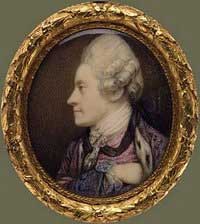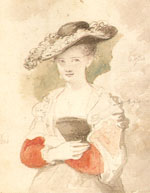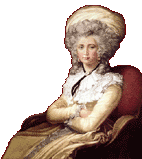Richard Cosway
William Richard Cosway was born on the 5th of November 1742 in Tiverton, Devon, England and moved to London in 1754 where he enrolled in the art school of teacher William Shipley. He was a short man but always used to wear such gaudy fashion clothes, that he had been labelled "maccaroni painter", as he appeared as the most showy artist.
In 1781 Richard married Maria Hadfield, of whom he painted portraits in different ways and poses. Cosway was a good manager of his wife Maria, and pretended not to see the attention that many man in power paid towards her.
 He was most known as a miniature portrait painter and as primarius pictor serenissimi Williae Principis of the Prince of Wales, who then became reigning King George IV; the praises of Richard Cosway as painter and author of mythological, historical and biblical refined compositions were also sung. During his career, he exposed his works at the Royal Academy, of which he had been co-founder, but his artistic production caused suddenly quite a stir for the prints that some of the most-known engravers of the time, like Francesco Bartolozzi e Wiliam Sharp, had got from his works.
He was most known as a miniature portrait painter and as primarius pictor serenissimi Williae Principis of the Prince of Wales, who then became reigning King George IV; the praises of Richard Cosway as painter and author of mythological, historical and biblical refined compositions were also sung. During his career, he exposed his works at the Royal Academy, of which he had been co-founder, but his artistic production caused suddenly quite a stir for the prints that some of the most-known engravers of the time, like Francesco Bartolozzi e Wiliam Sharp, had got from his works.
Richard was appreciated as a virtuous man and connoisseur, he had been formed in accordance with classical style, typical in the end of XVIII. His paintings ranged over subjects that went from mythological to literary ones, he also specialised in conversation pieces like Poussin's, in which he mixed the artistic language of family groups to the portrait taste typical of Reynolds. He was also very careful when he outlined parade portraits, or at least official ones, not only for the court members, but also when it was for himself or for his own family; he worked several times on his self-portrait acquiring evocations from Rubens or Van Dyck. In fact, the drawings by pen of the Cosway Foundation in Lodi are well-known : they represent his self-portrait with the busts of Michelangelo and Rubens, and Maria's Portrait with the bust of Leonardo.
 A choice of Richard's graphic production that is kept in Lodi, shows us how the artist is influenced by that poetic style typical of the end of XVIII century; there is also a particular interest for the neo-attican purism, but at the same time it's altogether connected to the sturmerians developments which let us think of Füssli in some of the visionary paintigs or in the illustrations from Spenser's tales.
A choice of Richard's graphic production that is kept in Lodi, shows us how the artist is influenced by that poetic style typical of the end of XVIII century; there is also a particular interest for the neo-attican purism, but at the same time it's altogether connected to the sturmerians developments which let us think of Füssli in some of the visionary paintigs or in the illustrations from Spenser's tales.
From the important collection of Richard Cosway, almost everything has got lost after the five auction sales organized by Maria herself, in London. What's left that testifies the richness of the collection is the printed catalogue of 1791, and maybe just one work that arrived in Lodi, the copperplate attributed to Francesco Albani with Il Cristo a mensa con gli Angeli. Among her husband's work, Maria brought to Lodi, where still they are kept, there are also some paintings of great interest: a self-portrait, an example of that specialized production that represented to Richard the ivory miniature (Portrait of Miss Elliot), some sacred paintings mainly of inspiration of Correggio, mystic allegories veined with the visionary painting by Füssli and Blake, like the Cristo confortato dagli Angeli.
Richard was appointed (1785) primarius pictor of the Prince of Wales. Richard's artistic production is very considerable, it witnesses English taste and fashion of the period between 1780 and 1820; his work is characterized by an extraordinary quality and by a soft and fluent stroke that testifies what a great draughtsman he was, besides being a virtuous painter of miniatures, at that time considered quite fashionable.
He died in London, on the 4th of july 1821, and was buried in the New Church in Marylebone.
![]()
Fondazione Maria Cosway Via Paolo Gorini, 6 26900 Lodi C.F. 84511920153

